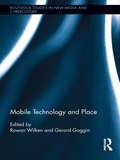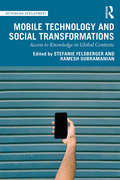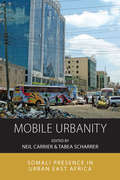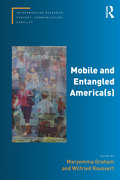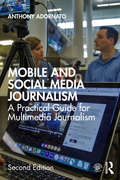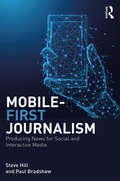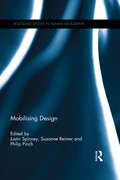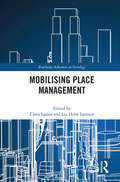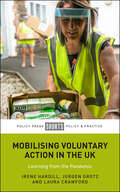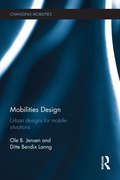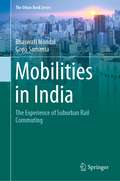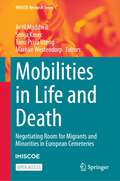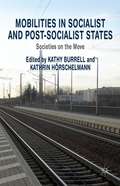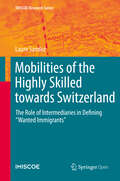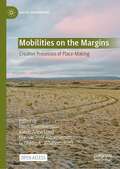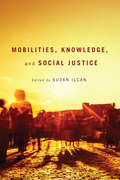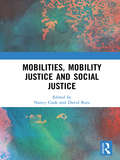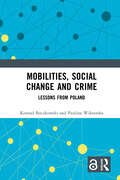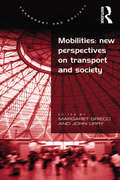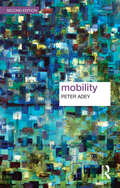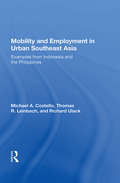- Table View
- List View
Mobile Technology and Place (Routledge Studies in New Media and Cyberculture)
by Gerard Goggin Rowan WilkenAn international roster of contributors come together in this comprehensive volume to examine the complex interactions between mobile media technologies and issues of place. Balancing philosophical reflection with empirical analysis, this book examines the specific contexts in which place and mobile technologies come into focus, intersect, and interact. Given the far-reaching impact of contemporary mobile technology use – and given the lasting importance of the concept and experiences of place – this book will appeal to a wide range of scholars in media and cultural studies, sociology, and philosophy of technology.
Mobile Technology and Social Transformations: Access to Knowledge in Global Contexts (Rethinking Development)
by Stefanie FelsbergerThis book investigates the ways in which the mobile telephone has transformed societies around the world, bringing both opportunities and challenges. At a time when knowledge and truth are increasingly contested, the book asks how mobile technology has changed the ways in which people create, disseminate, and access knowledge. Worldwide, mobile internet access has surpassed desktop access, and it is estimated that by 2022 there will be AN excess of 6 billion mobile phone users in the world. This widespread proliferation raises all sorts of questions around who creates knowledge, how is that knowledge shared and proliferated, and what are the structural political, economic, and legal conditions in which knowledge is accessed. The practices and power dynamics around mobile technologies are location specific. They look different depending on whether one chooses to highlight the legal, social, political, or economic context. Bringing together scholars, journalists, activists and practitioners from around the world, this book embraces this complexity, providing a multifaceted picture that acknowledges the tensions and contradictions surrounding accessing knowledge through mobile technologies. With case studies from Hong Kong, South Korea, India, Syria, Egypt, Botswana, Brazil, and the US, this book provides an important account of the changing nature of our access to knowledge, and is key reading for students, researchers, activists and policy makers with an interest in technology and access to knowledge, communication, social transformation, and global development.
Mobile Urbanity: Somali Presence in Urban East Africa (Integration and Conflict Studies #20)
by Neil Carrier Tabea ScharrerThe increased presence of Somalis has brought much change to East African towns and cities in recent decades, change that has met with ambivalence and suspicion, especially within Kenya. This volume demystifies Somali residence and mobility in urban East Africa, showing its historical depth, and exploring the social, cultural and political underpinnings of Somali-led urban transformation. In so doing, it offers a vivid case study of the transformative power of (forced) migration on urban centres, and the intertwining of urbanity and mobility. The volume will be of interest for readers working in the broader field of migration, as well as anthropology and urban studies.
Mobile and Entangled America (InterAmerican Research: Contact, Communication, Conflict)
by Maryemma Graham Wilfried RaussertA superb combination of focused case studies and high level conceptual thinking, this volume is an important monument in the ongoing development of Inter-American studies The articles gathered here closely examine a wide variety of cultural phenomena implicated in the 'entanglements' which have defined the history of the Americas. From religious networks to music and dance, and across a range of literary and artistic works, the mobility of people, objects, and ideas in the Americas is expertly mapped. At the same time, the book represents a serious enterprise of theory-building. Drawing on the histories of postcolonial thought, mobility studies, and work on human migration, Mobile and Entangled America(s) clearly establishes a new interdisciplinary field attentive both to the complexities of cultural form and the pervasiveness of power relations. Each article stands as a significant piece of scholarship on its own, but all are in dialogue with each other. The result is a richly satisfying and important volume of cultural scholarship.
Mobile and Social Media Journalism: A Practical Guide for Multimedia Journalism
by Anthony AdornatoNow in its second edition, Mobile and Social Media Journalism continues to be an essential resource for learning how journalists and news organizations use mobile and social media to gather news, distribute content, and engage with audiences. Merging theory and practice, the book includes checklists and practical activities in every chapter, enabling readers to immediately build the mobile and social media skills that today’s journalists need and which news organizations expect. The second edition retains a focus on journalism’s core values, such as authentication, verification, and credibility, while guiding readers on how to apply them to digital media activities. The book also offers an in-depth discussion of the audience’s active role in producing content, how mobile devices and social media have changed the way the audience consumes news, and what these changes mean for journalists. Updated to address the latest trends in multimedia journalism, the second edition includes two new chapters: "Writing mobile-friendly web stories" and "The spread of fake news". This is a valuable resource for journalism students, as well as media professionals seeking to update their skills. The book also features a companion website at www.mobileandsocialmediajournalism.com, providing online resources for students and lecturers, including video tutorials, industry news, and sample assignments. The book’s Twitter account (@MobileJourn) and Facebook page (fb.com/MobileandSocialMediaJournalism) share the latest industry trends and offer tips for teaching the topic.
Mobile-First Journalism: Producing News for Social and Interactive Media
by Steve Hill Paul BradshawMedia publishers produce news for a full range of smart devices – including smartphones, tablets and watches. Combining theory and practice, Mobile-First Journalism examines how audiences view, share and engage with journalism on internet-connected devices and through social media platforms. The book examines the interlinked relationship between mobile technology, social media and apps, covering the entire news production process – from generating ideas for visual multimedia news content, to skills in verification and newsgathering, and outputting interactive content on websites, apps and social media platforms. These skills are underpinned with a consideration of ethical and legal concerns involving fake news, online trolling and the economics of mobile journalism. Topics include: understanding how mobile devices, social media platforms and apps are interlinked; making journalistic content more engaging and interactive; advice on how successful news publishers have developed mobile and social media strategies; adopting an approach that is entrepreneurial and user-centered; expert interviews with journalists, academics and software developers; learning key skills to launch and develop news websites, apps and social media outputs. Mobile-First Journalism is essential reading for journalism students and media professionals and of interest to those studying on courses in social and new media.
Mobilising Design (Routledge Studies in Human Geography)
by Justin Spinney, Suzanne Reimer and Philip PinchThis book brings together research working at the boundary between design knowledges and mobilities, offering a novel collection for both theorists and practitioners. Drawing upon detailed case studies, it demonstrates the diverse roles of design in shaping mobility at different spaces and scales: across cities; within different types of buildings and infrastructures; and through commuting, work and leisure activities. A range of international scholars illustrate the designed mobilities of car parks, traffic lights, street benches, pedestrian wayfinding systems and accessible design in the urban environment; they examine spaces within hospitals, airports and train stations and investigate design practices for bicycles, future urban vehicles and MotoGP motorcycle racing. Other contributions explore overlooked mobile artefacts such as television and video game remote controls, 3D printing and the types of packaging which enable objects themselves to move around. This book demonstrates how the tools, assumptions and processes of design shape spaces of mobility, and also illuminates how shifts in the fluidity and circulation of people, practices and materials in turn reconfigure practices of design. Mobilising Design develops multi-disciplinary understandings of design, drawing upon diverse literatures including design history, product design, architecture and cultural geography. By highlighting often invisible artefacts and associated knowledges and controversies, the book foregrounds the taken-for-granted ways in which everyday mobility is designed. It will be of interest to scholars in geography, sociology, economic history, architecture, design and urban theory.
Mobilising Place Management (Routledge Advances in Sociology)
by Claus LassenMobilizing Place Management makes an important contribution to the mobilities field by arguing for the need to rethink place management. It takes a point of departure in the mobilities turn and relational place thinking while exploring the relationship between place and mobility. In a world of increasing mobility and global competition between nations, cities and urban regions, the managing of places seems more relevant than ever before. By examining various examples of place and mobilities that range from the airport, rural village, tourist site, port-city to the city region, this book argues that the management of places can be informed and enhanced by installing a greater awareness and understanding of mobility. This insight could potentially improve the ability of current place management to translate a relational and mobilities-orientated thinking into concrete actions, instructions, interventions, designs, plans, policies and management control systems. The book will be essential reading for researchers, practitioners and students in the field of place management and across urban studies, planning, design, geography, sociology, tourism, transport and history.
Mobilising Voluntary Action in the UK: Learning from the Pandemic
by Irene Hardill, Jurgen Grotz and Laura CrawfordEPDF and EPUB available Open Access under CC-BY licence. The COVID-19 pandemic transformed the landscape of voluntary action. Some volunteering projects had to be paused, while others were delivered in different ways, but across all four UK nations large numbers of people began volunteering for the first time. This book provides an overview of the constraints and opportunities of mobilising voluntary action across the four UK nations during the pandemic. Sector experts and academics examine the divergent voluntary action policy frameworks adopted, the state and non-state supported volunteer responses, the changes in the profile of volunteers and the plans to sustain their involvement. This book addresses the urgent policy and practice need for evidence-based considerations to support recovery from the pandemic and to prepare for future emergencies.
Mobilities Design: Urban Designs for Mobile Situations (Changing Mobilities)
by Ole B. Jensen Ditte Bendix LanngContemporary society is marked and defined by the ways in which mobile goods, bodies, vehicles, objects, and data are organized, moved and staged. Against the background of the ‘mobilities turn’ this book articulates a new and emerging research field, namely that of ‘mobilities design’. The book revolves around the following research question: How are design decisions and interventions staging mobilities? It builds upon the ‘Staging Mobilities’ model (Jensen 2013) in an exploratory inquiry into the problems and potentials of the design of mobilities. The exchange value between mobilities and design research is twofold. To mobilities research this means getting closer to the ‘material’, and to engage in the creative, exploratory and experimental approaches of the design world which offer new potential for innovative research. Design research, on the other hand, might enter into a fruitful relationship with mobilities research, offering a relational and mobile design thinking and a valuable basis for design reflections around the ubiquitous structures, spaces and systems of mobilities.
Mobilities and Complexities
by Mimi Sheller Ole B. Jensen Sven KesselringThe new ‘mobilities turn’ has become a powerful perspective in social theory. John Urry’s oeuvre has been very influential in the emergence of this new field and has had lasting impacts on many scholars. This collection presents originally commissioned essays from leading scholars in the field who reflect on how Urry’s writing influenced the course of their research and theorizing. This volume gathers contributions in relation to John Urry’s path-breaking work. The new ‘mobilities turn’ made a strong imprint in European social theory and is beginning to make an impact in the Americas and Asia as well. It challenges mainstream theoretical and empirical approaches that were grounded in a sedentary and bounded view of states. It propels innovative thinking about social and media ecologies, complex systems and social change. It bridges many disciplines and methodologies, leading to new approaches to existing problems while also resonating with questions about both history and the future. Mobilities research marks the rise of academic and intellectual cooperation and collaboration ‘beyond societies’, as nations around the world face the ecological limits of contemporary mobility and energy systems. The contributors represent several national contexts, including England, Germany, Denmark, Finland, Taiwan, Brazil, Canada, Australia and the USA. This book collects personal essays and gives insight into a vivid network of scientists who have connections of various degrees to the late John Urry as an academic figure, an author and a person.
Mobilities in India: The Experience of Suburban Rail Commuting (The Urban Book Series)
by Gopa Samanta Bhaswati MondalThis book presents commuting as a new paradigm in mobility studies in the context of global south. It delves into suburban train commuting in Eastern India. The book interprets commuting not only as a means to attend work but also as a process producing kinetic event-space infused with different mobile practices, which is not determined by their locational fixity, rather can be cognized. It analyses the role of suburban train commuting in the metropolitan expansion of Kolkata, and the transformation of rural space into urban. The significant contribution of the book lies in explaining commuters’ experiencescape and the production of spatial fluidity in time capsule through commuting. It also explores the subjective reality of gendered commuting. The book uses a trans-disciplinary research design, blending quantitative and ethnographic research methods. The area selected for the empirical research is the Howrah-Bardhaman Main Railway Line (108 km), the first suburban railway line in Eastern India. Commuters originating from three adjacent districts of Purba Bardhaman, Hooghly and Howrah took part in this research. Besides the commuters, non-commuting passengers and hawkers in the train were also interviewed to understand the diverse perceptions of the process of commuting. This book may be considered as a reference book for mobility studies, transport studies, urban geography and regional planning.
Mobilities in Life and Death: Negotiating Room for Migrants and Minorities in European Cemeteries (IMISCOE Research Series)
by Avril Maddrell Tanu Priya Uteng Mariske Westendorp Sonja KmecThis open access book focuses on migrant and minority cemetery needs through the conceptual lens of the mobilities of the living and the dead. In doing so, the book brings migration and mobility studies into much-needed dialogue with death studies to explore the symbolically and politically important issue of culturally inclusive spaces of cemeteries and crematoria for migrants and established minorities. The book addresses majority and minority cemetery and crematoria provisions and practices in a range of North West European contexts. It describes how the planning, management and use of cemeteries and crematoria in multicultural societies can tell us about the everyday lived experiences of migration and migrant heritage, urban diversity, social inclusion and exclusion in Europe, and how these relate to migrant and minority experience of lived citizenship, practices of territoriality and bordering, colonial/postcolonial narratives. The book will be of interest to readers in the fields of migration/mobilities studies and death studies, as well as policy makers and practitioners, such as local government officers, cemetery managers and city planners.
Mobilities in Socialist and Post-Socialist States
by Kathy Burrell Kathrin HörschelmannThis edited collection explores what mobility meant, and means, in the specific contexts of socialist and post-socialist Soviet and East European societies. Under the socialist regimes, mobility was at the heart of everyday interactions with the state, from controls on travel and communications mobilities to daily experiences of transport usage and the immobility of queuing for goods at times of shortages. These mobilities have been reshaped under post-socialist regimes. While the collapse of socialism heralded a liberalization of international migration and increased automobility, new experiences of poverty, unemployment, and in the case of some states, war, plus the loss of subsidized travel greatly reduced fields of mobility. Bringing together contributors from the dynamic fields of Mobilities and Socialist/Post-Socialist Studies this book uses the focus on socialist and post-socialist mobilities to investigate fundamental intersections of power, control, resistance and inequality.
Mobilities of the Highly Skilled towards Switzerland: The Role of Intermediaries in Defining “Wanted Immigrants” (IMISCOE Research Series)
by Laure SandozThis open access book analyses the strategies of migration intermediaries from the public and private sectors in Switzerland to select, attract, and retain highly skilled migrants who represent value to them. It reveals how state and economic actors define “wanted immigrants” and provide them with privileged access to the Swiss territory and labour market. The analysis draws on an ethnographic study conducted in the French-speaking Lake Geneva area and the German-speaking northwestern region of Switzerland between 2014 and 2018. It shows how institutional actors influence which resources are available to different groups of newcomers by defining and dividing migrants according to constructed social categories that correlate with specific status and privileges. This research thus shifts the focus from an approach that takes the category of highly skilled migrant for granted to one that regards context as crucial for structuring migrants’ characteristics, trajectories, and experiences. Beyond consideration of professional qualifications, the ways decision-makers perceive candidates and shape their resource environments are crucial for constructing them as skilled or unskilled, wanted or unwanted, welcome or unwelcome.
Mobilities on the Margins: Creative Processes of Place-Making (Arctic Encounters)
by Katrín Anna Lund Gunnar Thór Jóhannesson Björn Thorsteinsson Guðbjörg R. JóhannesdóttirThis open access book examines places on the margins and the dynamics through which a marginal position of a place is created. Specifically, it explores how places, mostly in sparsely populated areas, often perceived as immobile and frozen in time, come into being and develop through interference of everyday mobilities and creative practices that cut across the spheres of culture and nature as usually defined. Through fieldwork and case studies from areas in Iceland, Finland, Greenland, and Scotland, the book’s twelve chapters draw out the multiple relations through which places emerge, where people compose their lives as best they can with their surroundings. A special concern is to explore the links between travelling, landscape, and material culture and how places and margins are enacted through mobilities and creative practices of humans and other beings. The emphasis on mobility disturbs the perception of a place as a bounded entity and offers a useful and necessary understanding of places as mobile and fluid. Mobilities on the Margins is a novel and timely contribution to the exploration of human and more-than-human interactions in a world of increasingly fluid mobilities and insistent crises.
Mobilities, Knowledge, and Social Justice
by Suzan IlcanThe mobility of people, objects, information, ideas, services, and capital has reached levels unprecedented in human history. Such forms of mobility are manifested in continued advances in communication and transportation capacities, in the growing use of digital and biometric technologies, in the movements of Indigenous, migrant, and women's groups, and in the expansion of global capitalism into remote parts of the world. Mobilities, Knowledge, and Social Justice demonstrates how knowledge is mobilized and how people shape, and are shaped by, matters of mobility. Richly detailed and illuminating essays reveal the ways in which issues of mobility are at the centre of debates, ranging from practices of belonging to war and border security measures, from gender, race, and class matters to governance and international trade, and from citizenship and immigration policies to human rights. Contributors analyze how particular forms of mobility generate specific types of knowledge and give rise to claims for social justice. This collection reconsiders mobility as a key term in the social sciences and humanities by delineating new ways of understanding how mobility informs and shapes lives as well as social, cultural, and political relations within, across, and beyond states. Contributors include Rob Aitken (Alberta), Tanya Basok (Windsor), Janine Brodie (Alberta), William Coleman (Waterloo), Ronjon Paul Datta (Alberta), Karl Froschauer (Simon Fraser), Daniel Gorman (Waterloo), Amanda Grzyb (Western), Suzan Ilcan (Waterloo), Eleonore Kofman (Middlesex), Anita Lacey (Auckland), Theresa McCarthy (Buffalo), Daniel J. Paré (Ottawa), Nicola Piper (Sydney), Parvati Raghuram (Open), Kim Rygiel (Wilfrid Laurier), Leslie Regan Shade (Toronto), Sandra Smeltzer (Western ), Daiva Stasiulis (Carleton), Myra Tawfik (Windsor), and Lloyd Wong (Calgary).
Mobilities, Knowledge, and Social Justice
by Suzan IlcanThe mobility of people, objects, information, ideas, services, and capital has reached levels unprecedented in human history. Such forms of mobility are manifested in continued advances in communication and transportation capacities, in the growing use of digital and biometric technologies, in the movements of Indigenous, migrant, and women's groups, and in the expansion of global capitalism into remote parts of the world. Mobilities, Knowledge, and Social Justice demonstrates how knowledge is mobilized and how people shape, and are shaped by, matters of mobility. Richly detailed and illuminating essays reveal the ways in which issues of mobility are at the centre of debates, ranging from practices of belonging to war and border security measures, from gender, race, and class matters to governance and international trade, and from citizenship and immigration policies to human rights. Contributors analyze how particular forms of mobility generate specific types of knowledge and give rise to claims for social justice. This collection reconsiders mobility as a key term in the social sciences and humanities by delineating new ways of understanding how mobility informs and shapes lives as well as social, cultural, and political relations within, across, and beyond states. Contributors include Rob Aitken (Alberta), Tanya Basok (Windsor), Janine Brodie (Alberta), William Coleman (Waterloo), Ronjon Paul Datta (Alberta), Karl Froschauer (Simon Fraser), Daniel Gorman (Waterloo), Amanda Grzyb (Western), Suzan Ilcan (Waterloo), Eleonore Kofman (Middlesex), Anita Lacey (Auckland), Theresa McCarthy (Buffalo), Daniel J. Paré (Ottawa), Nicola Piper (Sydney), Parvati Raghuram (Open), Kim Rygiel (Wilfrid Laurier), Leslie Regan Shade (Toronto), Sandra Smeltzer (Western ), Daiva Stasiulis (Carleton), Myra Tawfik (Windsor), and Lloyd Wong (Calgary).
Mobilities, Mobility Justice and Social Justice
by Nancy Cook David ButzThis book offers a cutting-edge overview of mobility, mobility justice and social justice, with contributions from a broad range of leading scholars. Mobility justice is understood as a way to frame the entanglements of power and social exclusion in the mobilities of humans, things, and ideas, as well as to differential and unequal access to movement, and the ability to move. The introductory chapters firmly ground the concept of mobility justice and social justice, with the proceeding chapters covering a range of topics from race, sexuality, ferry justice and aeromobility justice, animal mobilities, design, and food mobilities.
Mobilities, Social Change and Crime: Lessons from Poland
by Konrad Buczkowski Paulina WiktorskaThis book presents a synthesis of selected trends in the dynamics and structure of crime in Poland over the past 30 years, in the context of ongoing social transformations in the wider region. The book explores the impact of the deep systemic transformation of the late 1980s and early 1990s on the phenomenon of crime, its structure and dynamics, and the policy of its control in the following decades. It also examines the impact of changes resulting from the dynamic development of Polish society in the 21st century in the context of global changes towards the emergence of a new form of collective life, a mobile information society based on modern technologies. The focus is primarily on those deviant behaviours that can most obviously be linked to social changes, primarily political, economic, legal, and technological. The work examines disclosed crime figures available in official statistics. It also looks to the future considering the global societal changes caused by the outbreak of the COVID-19 pandemic. Based on preliminary observations made in selected countries, the authors describe associated changes in criminal behaviour and identify some pivotal developments that may influence future trends. The book will be of interest to academics and researchers working in the areas of criminal law, criminology, sociology and criminal policy.
Mobilities, Social Change and Crime: Lessons from Poland
by Konrad Buczkowski Paulina WiktorskaThis book presents a synthesis of selected trends in the dynamics and structure of crime in Poland over the past 30 years, in the context of ongoing social transformations in the wider region. The book explores the impact of the deep systemic transformation of the late 1980s and early 1990s on the phenomenon of crime, its structure and dynamics, and the policy of its control in the following decades. It also examines the impact of changes resulting from the dynamic development of Polish society in the 21st century in the context of global changes towards the emergence of a new form of collective life, a mobile information society based on modern technologies. The focus is primarily on those deviant behaviours that can most obviously be linked to social changes, primarily political, economic, legal, and technological. The work examines disclosed crime figures available in official statistics. It also looks to the future considering the global societal changes caused by the outbreak of the COVID-19 pandemic. Based on preliminary observations made in selected countries, the authors describe associated changes in criminal behaviour and identify some pivotal developments that may influence future trends. The book will be of interest to academics and researchers working in the areas of criminal law, criminology, sociology and criminal policy.
Mobilities: New Perspectives On Transport And Society (Transport and Society)
by John UrryBringing together the leading authors currently working at the intersection of social science and transport science, this volume provides a companion to the well-established and extensive international Transport and Society series. Each chapter, and the volume as a whole, offers closer and richer consideration of the issues, practices and structures of multiple mobilities which shape the current world but which have typically been overlooked or minimised. What this approach seeks to do is not only draw attention to many new areas of research and investigation relating to mobile lives, but also to point to new theories and methods by which such lives have to be researched and examined. Such new theories and methods are relevant both to rethinking 'transport' studies as such but are also recasting 'societal' studies as 'transport' so that it comes out of the ghetto and enters mainstream social science.
Mobility (Key Ideas in Geography)
by Peter AdeyMobility aims to take the pulse of this enormously expanded and energetic field. It explores the breadth of the disciplinary areas mobility studies now encompass, examining the diverse conceptual and methodological approaches wielded within the field, and explores the utility of mobility to illuminate a cornucopia of mobile lives: from the mass movements of individuals within global processes such as migration and tourism, to homelessness and war; from the entangled relations caught up in the movement of disease, people and aid across borders, to the inability of someone to cross over a road. The new edition explores the more sustained elaboration of mobility studies within a wide variety of disciplinary approaches and subject matters. It echoes the growing internationalization of mobility research, reflected in diverse case studies from the Global South, South Asia, Latin America, the Caribbean and so far under-represented perspectives from China, Australasia, post-socialist Eastern Europe, the Middle East and elsewhere. The book also features an additional chapter on mobility studies, to survey and explore the diverse quality of the field, and methodologies, in order to reflect the growing diversity of methodological approaches to mobilities, from walk-alongs and critical cartography to the mobile arts. The book offers an accessible reading of the way mobility has been tackled and understood, neatly exploring and summarizing a topic that has exploded into different variations and nuances. The text allows scholars and students alike to grasp the central importance of ‘mobility’ to social, cultural, political, economic and everyday terrains by providing accessible writings on key authors within key ideas and case study boxes, suggested further readings and summaries, while at the same time making a significant contribution to scholarly writings and debates.
Mobility And Employment In Urban Southeast Asia: Examples From Indonesia And The Philippines
by Michael A. CostelloThis study represents a new generation of inquiry that attempts to gain a better understanding of smaller urban places in the remote and frontier regions in Southeast Asia. A set of intriguing hypotheses attempting to unravel the complicated relationships between population movements and employment opportunities as they relate to the growth of certain urban places and the rural hinterland have been posited. The study is aimed at illuminating the processes of urbanization and development in North Sumatra Province of Indonesia and the Central Visayas and Northern Mindanao regions of the Philippines.
Mobility And Migration In Asian Pacific Higher Education
by Deane E. Neubauer Kazuo KurodaThrough case studies in eight Asian countries, Europe, and the United States, this volume explores the range and consequences of increased mobility within Asia-Pacific higher education and the patterns of migration emerging for persons, ideas, institutions, and practices.
